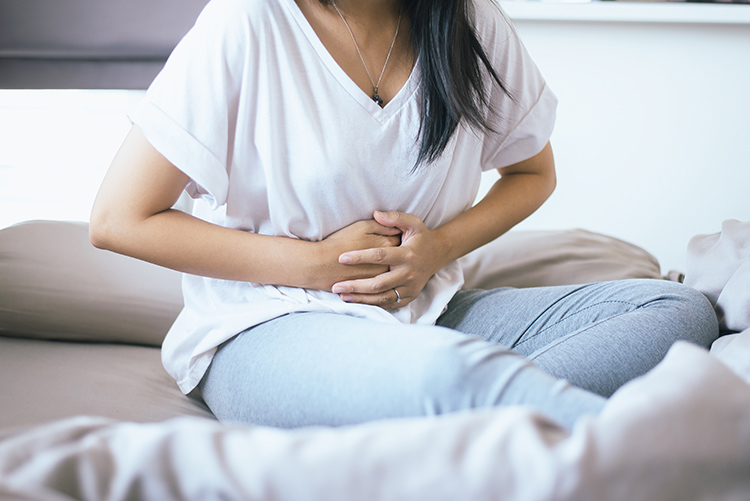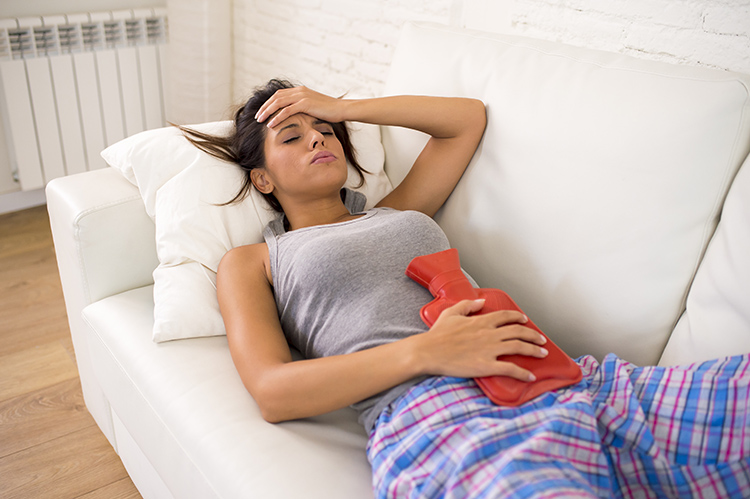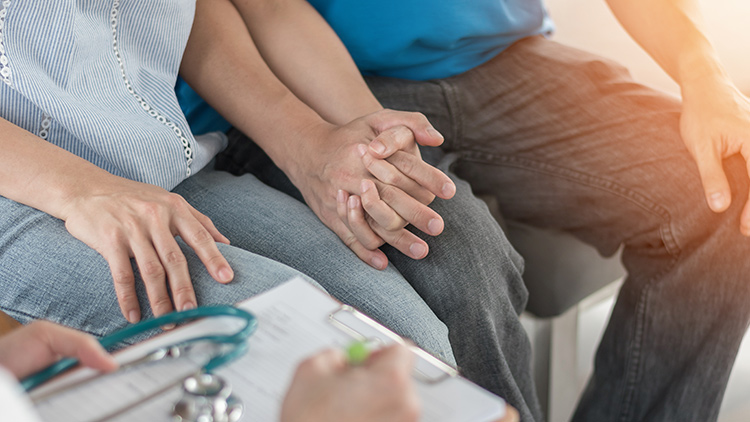East Melbourne VIC 3002
Pelvic Pain In Women: Causes & Symptoms

Pelvic pain is one of the most common symptoms experienced by women of all ages. It can significantly interfere with a woman’s lifestyle and it is important that a diagnosis and appropriate treatment are instigated.
Pelvic Pain Symptoms
There are many reasons why, as a woman you might develop mild to chronic pelvic pain in your life. We explore these conditions at length below:
Menstrual Pain & Cramping
Menstrual pain (dysmenorrhoea) is a common symptom associated with menses in women once they commence cycling.
There are two types of dysmenorrhoea or pelvic pain:
- Primary dysmenorrhoea – This indicates that the pain has been present ever since a woman has started having periods
- secondary dysmenorrhoea – This implies the pain has developed due to the development of some form of pathologies such as endometriosis or adenomyosis
Menstrual pain is often associated with cramping or a constant dull ache in the lower pelvis region. Period pain or menstrual pain can also be felt in the lower back, buttocks, down both legs or pain that travels up to the upper abdomen or even the shoulder tips. This is called referred pain.
With period pain, either primary or secondary there can be associated symptoms such as nausea, vomiting, bowel disorders including diarrhoea or constipation, fatigue and the feeling as if you are about to collapse.
How To Treat Menstrual Pain & Cramping
Whenever menstrual pain is severe enough to interfere with your quality of life and prevent activities such as involving work or play the pain needs to be addressed and treated, this is when making an appointment with your gynaecologist and or local GP is necessary.
Treatment of menstrual pain may just involve the use of adequate pain relief but other modalities such as physiotherapy or surgery may need to be considered, depending on the cause of the pain.

Ovulation
Ovulation refers to the part of the menstrual cycle where an egg is released. Common symptoms noted on or around the time of ovulation include a more copious thin mucus from the cervix as well as symptoms such as cramping pelvic pain, sore breasts, feeling bloated, a change in appetite, a feeling of fluid retention or even a change in mood.
Sometimes the actual process of ovulation results in a small amount of blood being released from the egg. This can be associated with a short-lived pain often lasting somewhere between 6-24 hours. This is because blood is an irritant when it is released within the abdominal cavity.
How To Treat Ovulation
Because these symptoms are usually short-lived the simplest thing is to take basic pain relief such as paracetamol or anti-inflammatory medications such as Naprosyn or other NSAIDs.
Endometriosis
Endometriosis is a condition where tissue that is very similar to the endometrial tissue or tissue that comes away with a period is located outside the uterine cavity. When this happens, it can cause a variety of symptoms, including significant period pain, pain with intercourse or constant pelvic pain not particularly related to the menstrual cycle. In some women, there are no symptoms at all, despite the extensive disease.
How to Treat Endometriosis
The treatment of endometriosis may depend on whether or not you are trying to conceive or want to conceive in the near future. Simple pain relief such as NSAIDs and paracetamol or even stronger pain relief including opioids may be necessary. In general, the most effective treatment is to have an operative procedure called a laparoscopy.
Dr Len Kliman specialises in gynaecological pelvic surgery and minimally invasive gynaecological surgery, including hysteroscopic and laparoscopic surgery.

Adenomyosis
Adenomyosis is a condition where the endometrial or lining of the uterus glands and supporting tissue are located within the muscle layer (myometrium) of the uterus.
The exact cause of this condition is unknown. It is diagnosed on symptoms, such as having an enlarged uterus and a classic appearance on ultrasound which is described as the “Venetian blind” effect. Adenomyosis can be focal or involve a single part of the uterus or it can be diffuse involving all of the uteri.
Adenomyosis Pain Symptoms are a Triad of:
- Heavy periods
- Painful periods
- Pain with intercourse
How to Treat Adenomyosis
The treatment for adenomyosis may include no treatment at all if there are no symptoms causing you concern. Though, the use of a Mirena-releasing IUD, or hormonal treatment such as a progesterone-only pill is very useful when it comes to managing adenomyosis.
If symptoms are debilitating and simpler forms of treatment have failed, a hysterectomy may be necessary but is usually the last option and obviously is only considered in women who are not considering childbirth or who have finished their family.
Ovarian Cysts or Masses
Ovarian cysts are masses or lumps on the ovary which can be either cystic or fluid-filled or solid tissue or both. In assessing an ovarian mass, the important consideration is whether or not there is a possibility it could be malignant rather than benign and whether or not it is causing acute or chronic symptoms. These two factors will decide whether or not surgery or surveillance is the correct form of treatment. An ovarian ultrasound or pelvic ultrasound can usually give us some idea as to the size and nature of the cyst and whether or not the cyst has a possibility of being malignant.
How to Treat Ovarian Cysts
The symptoms of an ovarian cyst (benign or malignant) may be obscure and minor such as bloating, general mild pelvic discomfort or indigestion-like symptoms. Occasionally if you haemorrhage into a cyst or the cyst twists, the pain can be acute and severe. In this case, surgery will be necessary to alleviate severe symptoms.

Sexually Transmitted Diseases
Pelvic pain in women may be a result of common sexually transmitted diseases, such as chlamydia and gonorrhoea.
The common symptoms of sexually transmitted diseases are an offensive or pus-like vaginal discharge, a lesion such as an ulcer on the genital area and pelvic pain if the sexually transmitted disease is associated with pelvic inflammatory disease. The infection will need to be diagnosed and treated and symptom control such as adequate pain relief should also be considered.
Uterine Fibroids
Uterine fibroids (leiomyomas) are the most common pelvic tumours in women. The actual frequency is unknown but probably occurs in 10-25% of all women in the reproductive age range. They vary in size from a few millimetres to 12 or more centimetres in diameter and are classified according to their position. They can be outside the muscle of the uterus, in the muscle of the uterus, in the cavity of the uterus or as part of the cervix or neck of the womb.
The symptoms of fibroids depend upon their severity and the size and position of the fibroids. Common symptoms include:
- Heavy periods – menorrhagia
- Pelvic pain or pressure symptoms – Compression symptoms imply that they are close and compress surrounding organs such as the bladder or bowel
- Interference with pregnancy – Uterine fibroids may increase the risk of miscarriage as fibroids within the cavity can interfere with implantation. They may increase the risk of complications during pregnancy such as babies presenting in the wrong position or an increased risk of haemorrhage. Red degeneration occurs when a fibroid begins to outgrow its blood supply in pregnancy and can be associated with significant pain.
How to Treat Uterine Fibroids
There are a number of alternative treatments for uterine fibroids with variable success including ultrasound-guided microwave therapy and blood vessel embolisation which interferes with the blood supply to the fibroid. Your particular treatment will depend on a number of factors and your treating practitioner can go through the pros and cons of each individual treatment option.
Non-Gynaecological Causes of Pelvic Pain
The pelvis is a large space and contains organs other than genital organs such as bowel, bladder and blood vessels. Therefore there are a number of non-gynaecological causes for pelvic pain that need to be considered whenever somebody presents with low abdominal or pelvic pain.
These conditions include:
- Irritable bowel syndrome – This is a functional bowel disorder often associated with a diet low in fibre or other bowel conditions such as coeliac disease.
- Cystitis – This is an inflammation of the bladder, often caused by bladder infections
A controversial cause of pelvic pain is the notion of pelvic congestion where large varicose veins occur in the pelvis, especially in women who have had a number of children. This is given the name of pelvic congestion syndrome and is described as a dull aching pelvic discomfort. Dr Kliman personally believes that this condition does not exist and the varicose veins are a variant of normal. Because the pelvis is made up of a number of muscles and ligaments, there are conditions where the pain is primarily muscular or involves the joints of the pelvis. This cause of pain is often helped by physiotherapy, especially a physiotherapist who specialises in pelvic pain.

When To See a Doctor
Whenever you develop a new symptom that has not occurred previously or could be a sign of a significant condition, medical advice should be sought. This includes abnormal bleeding and or pain. Any symptom that interferes with your quality of life or seems unusual such as bleeding after menopause (when it should not occur) needs further investigation.
With respect to pelvic pain, any pain that is not helped by simple analgesia and persists needs further investigation.
A Typical Gynaecological Examination
When you visit Dr Kliman, you will be met by staff members who are qualified nurses and will obtain all of your relevant details and will try and get a feeling for what your particular problem is.
- Dr Kliman will introduce himself and take you into his consulting room. Dr Kliman believes bedside manner is crucial so you will be made to feel relaxed and comfortable. It is a particularly non-threatening environment and all patients are treated with dignity and respect.
- A full medical and surgical history will be taken and possible diagnoses will be discussed. This will be followed by a general and gynaecological examination following an explanation of what this involves. If necessary, one of our registered nurses can be present to allay any anxiety.
- The need for further investigations will be discussed such as blood tests and potentially ultrasounds. Dr Kliman corresponds with all of his patients following the consultation to put into writing what has been discussed and what has been decided upon. He also communicates with your general practitioner and other specialists involved in your care.
The actual treatment of pelvic pain depends on the underlying cause. It is important to not just treat the pain but to treat whatever is causing the pain to allow for a complete cure. In the interim while, a diagnosis is being made and all necessary tests and treatment have been carried out the actual pain needs to be managed. This will involve modalities such as pain relief medication, physiotherapy and a thorough explanation.
Dr Kliman understands how distressing this symptom can be, especially if it has been ongoing for some time. It is important that the pain and its underlying cause are managed appropriately resulting in both a diagnosis and relief from symptoms.
With over 30 years experience in the field, Dr Len Kliman is highly regarded as one of Melbourne’s leading gynaecologists. If you’re in need of some guidance, or would like to discuss your symptoms then call our office – our highly-experienced nurses are ready to assist you.








